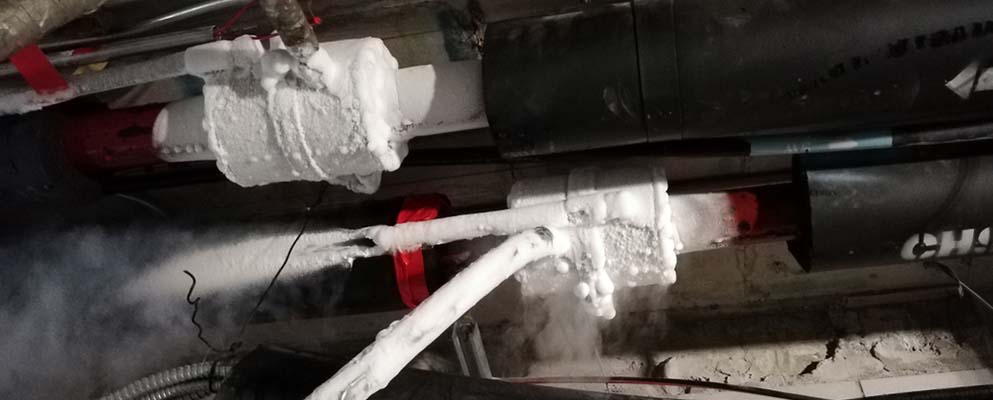
GLYCOL CHILLER VS. WATER CHILLER – WHY USE GLYCOL?
The global demand for industrial process cooling remains at a steady high. Reliability and minimal downtime are key to consistent and profitable industrial and commercial processes.
This article will consider the best methods to attain the optimal temperatures required to operate production processes in the metal finishing, medical, brewing, and agricultural industries.

How Does A Chiller Function?
So, how does a chiller work? The process works in a loop, but we will start where the cooling medium interfaces with your process equipment.
The system’s coolant absorbs thermal energy from your process, typically causing a phase change into a gas. The gaseous refrigerant is then circulated to a condenser which expels the heat through evaporative condensation or a cooling tower. This heat exchange condenses the cooling medium back into a cooler liquid that is sent back to process heating source to begin the cycle again.
What Type of Coolants Are Used in Chillers?
The type of coolant utilized in a chiller is based on process needs and cost considerations. The most popular coolants used are either water or a mixture of water and another substance with suitable heat conduction properties – like glycol compounds.
Water
The use of water as chiller fluid is an economical one as in most cases the water can be easily sourced with minimal costs. Alternatively, purified (deionized water, reverse osmosis) water can be used in a water-based chiller to achieve a higher cooling efficiency.
Glycol
Glycol based coolants are either composed of ethylene glycol or propylene glycol. While these two variants have similar physical properties, they should never be mixed. The major advantages which glycol coolants confer are an improved resistance to corrosion as well as antifreeze properties.
Why Is Glycol Used for Cooling
Using a glycol-water mix as a chiller coolant has various benefits over the use of plain water as a chiller fluid. These advantages are due to its unique physical properties which include a lower freezing point than water.
Water vs. Glycol Heat Transfer
For water free of impurities, the freezing point is 32°F which is much higher compared to pure ethylene glycol which changes to its solid-state at 8.9°F. When a glycol-water mixture is altered, the freezing point of the coolant also changes. To cite an example, 10% ethylene glycol will freeze at 25.9°F while a 60% glycol solution will freeze at -63°F.
From the above analysis, it’s clear that glycol has refrigerant properties that are more suited for use in chillers expected to function in low-temperature environments. In these thermal conditions, a water coolant will freeze and obstruct chiller circulation while diminishing overall efficiency.
By contrast, utilizing a glycol-based chiller will take advantage of its antifreeze properties ensuring the coolant remains in a desirable fluid state.

Glycol Chiller vs. Water Chiller
Both glycol and water chillers can be used to satisfactorily dissipate the heat being generated by your production process. The fundamental difference between both chiller types lies in variations in their freezing points as well as their heat conduction capacities.
Pure glycol or a mix of glycol and water has a much lower freezing point than that of pure water. By implication, glycol-based chillers are better suited to low-temp environments. Conversely, water has a better ability to retain and conduct heat from an associated process than a glycol mixture can. As a result, the efficiency of heat transfer for a water chiller will be higher than that of a glycol chiller.
Overall, operators need to consider the ambient temperatures for the siting environment before choosing a chiller type.
How Does a Glycol Chiller System Work?
A glycol chiller plant is composed of a refrigeration component and tubing containing a glycol-water mixture as coolant. Chilled fluid from the refrigeration unit is channeled through the piping associated with a thermal exchanger surrounding a heated process. After absorbing heat from the associated process, the warmed coolant is returned to the refrigeration unit for cooling after which the process is repeated.
Percentage Glycol in Chilled Water Systems
For many chiller types, ethylene glycol is mixed with water at a ratio of 60/40. This higher percentage of glycol boosts the mixture’s antifreeze properties significantly. This is useful in cases where rapid cooling is required. In these situations, a process can be cooled to very low temperatures without freezing the coolant within its piping.
How Does a Water Chiller System Work?
A conventional water chiller works on the principles of heat transmission between various mediums both fluid and solid. These cooling systems work either by heat absorption or vapor compression. The basic components of a water chiller system include a refrigeration unit and a piping system that circulated chilled coolant.
See Cold Shot Chillers’ Line of Performance Chillers
For the last thirty years, Cold Shot Chillers has been manufacturing premium industrial chillers. With an impressive line of water- and air-cooled chiller units, your industrial cooling needs are sure to be met.
Contact us online today to learn more about our process cooling solutions.